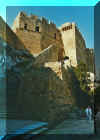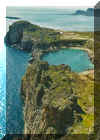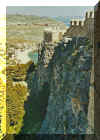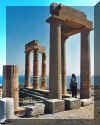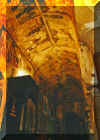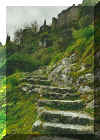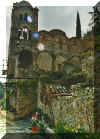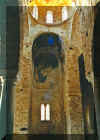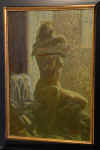|
|
A Couple Stops in Greece! |
|
|
Getting off the cruise ship in Gythion
|
March 21, 2000 - Mediterranean CruiseRhodes, GreeceAfter leaving Cyprus, the ship followed the Turkish coast line to the Greek island of Rhodes and port city of Rhodes. After leaving the ship, we boarded our bus straigt to the ancient sea side city of Lindos. After awonderful time walking all over the city of Lindos, we returned to Rhodes where we had time for more touring and shopping. During our shopping, we found the most spectacular painting of a woman dressing that we have ever purchased. March 22, 2000 - Mediterranean CruiseGythion, GreeceIn Gythion, the ship couldn't dock at the pier so we were fairied in on smaller boats. Once on the pier, we took our bus straigt to the town of Mistra and the mountain fortress. After touring the town of Mistra and hiking to the fortress, we took the bus back to Gythion for relaxing shopping and wandering the town.
|
Map of the cruise route
|
|
Lindos Lindos was founded by the Dorians led by the king Tlepolemus of Rhodes, who arrived in about the 10th century BC. Above the modern town of Lindos is the acropolis of Lindos, a natural citadel which was fortified successively by the Greeks, the Romans, the Byzantines, the Knights of St John and the Ottomans. While we were there, we were able to walk all around the acropolis and see all the wonderful sites. The only thing we didn't have time to do, was to explore the city of Lindos. |
||
The island of Rhodes has been inhabited since the 16th century BC. Inhabited by many cultures, the city was widly known for the massive port statue of the sun god Helios, called the colossus of Rhodes. At the time, the statue was the largest in the world. Sadly, it was damaged during the 226 BC earthquake that destroyed much of the city. Over the centuries, the statue was broken apart and sold. Today the city and island is a major tourist detination with modern amenities next to remains of centuries old historic sites. We could have spent many weeks here touring all the sites.
Mistra
Mystras, the 'wonder of the Morea', was built as an amphitheatre around the fortress erected in 1249 by the prince of Achaia, William of Villehardouin. Reconquered by the Byzantines, then occupied by the Turks and the Venetians, the city was abandoned in 1832, leaving only the wonderful medieval ruins. Most of the group stayed below in the city while we had the hiking trail to the fortress all to ourselves.
Gythion (Gytheio)
Gythion was once the port of ancient Sparta until it was destroyed in the 4th century AD, most likely by an earthquake. Today, most of the ruins of Gythion lie beneth the water. However, the city is a vibrant and colorful port city that we wish we could have spent more time touring and photographing. To this day, our photo of the harbor and the octopus hanging to dry is one of our favorite photos of all time. The reason we didn't get much time to tour the city was that we walked into an art gallery to look at the art and Sheena eyed the painting that Eddie had been looking for a long time. Eddie had walked right past it sitting on the floor, but when Sheena saw it, and we knew we had to purchase it. We were willing to pay full price since we were running late to catch our ship, but the shop owner would have none of it. All deals must be barterred. In the end, we payed full price and he paid for the shipping to the U.S. Our tour guide was in a panic when she saw us because the last boat was leaving to take passengers back to the ship anchored in the harbor. When we returned home to the U.S., we found our painting crated in a wooden container that could probably withstand a tank parked on it!









